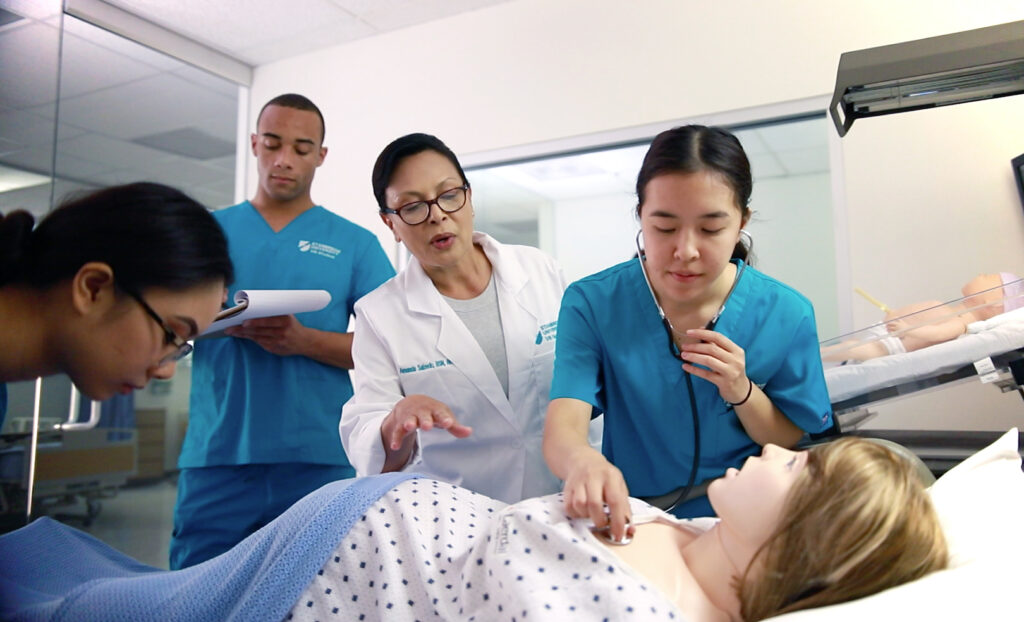LVN vs. CNA: Key Differences

TL;DR
Licensed Vocational Nurses (LVNs) and Certified Nursing Assistants (CNAs) play vital roles in patient care but differ in training, responsibilities, and salary potential. LVNs complete longer educational programs and have a broader scope of practice, while CNAs provide essential support in basic patient care. CNAs often use their experience as a stepping stone to advance into LVN or RN roles.¹,²
Choosing the right entry point into nursing can be challenging, especially when comparing LVN vs. CNA career paths. Both roles are essential to the healthcare system and offer unique opportunities for professional growth. Understanding the distinctions in education, responsibilities, and advancement potential can help aspiring healthcare professionals make informed decisions about which path best aligns with their goals.
LVN vs. CNA: Understanding the Two Nursing Roles
Both Licensed Vocational Nurses (LVNs) and Certified Nursing Assistants (CNAs) support patients in medical settings¹,², but their roles differ significantly in responsibility and education.
LVNs are licensed healthcare professionals who deliver direct patient care under the supervision of Registered Nurses (RNs) or physicians.² CNAs assist with daily activities such as bathing, feeding, and mobility, making them essential members of the healthcare team.¹
Although both positions are integral to patient well-being, understanding their differences can help aspiring healthcare professionals choose the right path for their career goals.
1. Education and Training Requirements
The path to becoming an LVN typically requires completing a state-approved vocational nursing program, which can take about 17 to 19 months to complete and includes both classroom instruction and clinical practice.³ Graduates must pass the National Council Licensure Examination for Practical Nurses (NCLEX-PN) to obtain licensure.⁴
In contrast, CNA programs are much shorter, often ranging from 4 to 12 weeks, and focus on foundational patient care skills. CNAs must pass a state competency exam to earn certification.¹ This shorter timeline makes CNA training an appealing entry point into the healthcare field for those seeking immediate employment.
2. Scope of Practice and Job Responsibilities
LVNs have a broader scope of practice than CNAs. They can administer medications, perform wound care, monitor vital signs, and assist with treatment plans under the supervision of an RN or physician. LVNs may also supervise CNAs in certain settings.²

CNAs, on the other hand, provide basic patient care such as hygiene assistance, repositioning, feeding, and reporting changes in patient condition to nursing staff.¹ While their duties are limited compared to LVNs, CNAs play an essential role in ensuring patient comfort and safety.
Is a CNA higher than an LVN? No. LVNs hold a higher level of education and licensure than CNAs, with greater clinical responsibilities and a broader scope of practice.
3. Career Growth and Advancement Opportunities
The career outlook for Licensed Vocational Nurses (LVNs) in California remains strong. According to the California Employment Development Department (EDD), employment for LVNs is projected to grow by 17.8% from 2022 to 2032, adding nearly 13,900 new positions statewide.⁵ This growth reflects rising demand in hospitals, nursing care facilities, and home health services as California’s population continues to age.
The CNA position also often serves as a gateway to nursing careers, with many professionals later pursuing LVN or RN licensure. Those who advance from CNA to LVN typically experience higher earning potential and a wider range of employment opportunities.⁶

4. Work Environments
Both LVNs and CNAs work in hospitals, long-term care facilities, rehabilitation centers, and clinics.² However, LVNs may also find employment in more specialized settings, such as outpatient care centers or home healthcare services, where their clinical skills are in higher demand.²
CNAs are more commonly employed in long-term care facilities and nursing homes, providing direct support to elderly or chronically ill patients who need daily care.¹
5. Career Pathways: From CNA to LVN to RN
Many healthcare professionals begin their journey as CNAs to gain hands-on experience before advancing to higher nursing credentials. Some vocational nursing programs even give preference to applicants with CNA experience.
Do you need to be a CNA to become an LVN? Not necessarily. While prior CNA experience can strengthen your application and clinical readiness, it is not a prerequisite for admission into most LVN programs.⁷
This natural progression, from CNA to LVN, and eventually to RN, allows individuals to build experience, education, and earning potential over time.
The Vocational Nursing (LVN) program offered at Stanbridge University offers classroom instruction and clinical training designed to support students in developing patient care skills. Learn more about Stanbridge’s commitment to excellence in nursing education by visiting the Vocational Nursing program page, and schedule a meeting with our Admissions team to discuss how you can take the next step toward your nursing career.
Stanbridge University offers healthcare degree programs across its Southern California campuses in Irvine, Alhambra, Riverside, and San Marcos. The university has been recognized for both academic excellence and workplace culture, including recognition in the 2025 Carnegie Classifications as an Opportunity College8 and in Research.com’s 2024 Best Healthcare Degree Programs in America.9 Its Orange County campus earned the 2024–2025 ACCSC School of Excellence Award,10 and in 2025, Georgetown University’s Center on Education and the Workforce ranked Stanbridge among the top 5% of U.S. colleges for 10-year return on investment, based on earnings and tuition data from qualifying programs.11 Stanbridge is accredited by Investors in People (London)12 and certified as a Great Place to Work.13
Frequently Asked Questions
No. LVNs hold a higher level of education and licensure than CNAs, with greater clinical responsibilities and a broader scope of practice.
No, CNA certification is not required before becoming an LVN, though it can provide valuable foundational experience.
Starting as a CNA offers quick entry into healthcare, while becoming an LVN provides more autonomy, higher pay, and broader career opportunities.
LVN programs typically take 17 to 19 months to complete,³ while CNA training can be finished in as little as 4 to 12 weeks.¹
Footnotes
¹ Source: Bureau of Labor Statistics, U.S. Department of Labor, Occupational Outlook Handbook, Nursing Assistants and Orderlies, https://www.bls.gov/ooh/healthcare/nursing-assistants.htm. As viewed on October 10, 2025.
² Source: Bureau of Labor Statistics, U.S. Department of Labor, Occupational Outlook Handbook, Licensed Practical and Licensed Vocational Nurses, https://www.bls.gov/ooh/healthcare/licensed-practical-and-licensed-vocational-nurses.htm. As viewed on October 10, 2025.
³ Program duration subject to change. Completion times vary depending on the start and end dates of a cohort and any individual circumstances that may impact progression.
⁴ Source: National Council of State Boards of Nursing, NCLEX-PN Examination Overview, https://www.ncsbn.org/exams/nclex. As viewed on October 10, 2025.
⁵ Source: California Employment Development Department (EDD), Occupation Profile: Licensed Vocational Nurses (SOC Code: 29-2061) in California, https://labormarketinfo.edd.ca.gov/cgi/databrowsing/occExplorerQSDetails.asp?searchCriteria=+Licensed+Vocational+Nurse&careerID=&menuChoice=occexplorer&geogArea=0601000000&soccode=292061&search=Explore+Occupation. As viewed on October 10, 2025.
⁶ Source: U.S. Bureau of Labor Statistics, Career Outlook: From Nursing Assistant to Registered Nurse, https://www.bls.gov/careeroutlook/2015/article/nursing-assistant-to-rn.htm. As viewed on October 10, 2025.
⁷ Source: California Board of Vocational Nursing and Psychiatric Technicians (BVNPT), Licensing Requirements, https://www.bvnpt.ca.gov/applicants/licensing.shtml. As viewed on October 10, 2025.
8 Source: https://carnegieclassifications.acenet.edu/institution/stanbridge-university/. As viewed on May 21, 2025.
9 Source: Research.com, 2024 Best Healthcare Degree Programs Ranking in America, https://research.com/rankings/healthcare/best-healthcare-usa/?award=f3d66c8ef200b579. Email communication from Chief Data Scientist and Ranking Editor, Imed Bouchrika, Ph.D. to Director of Marketing, Victoria Sauer. As viewed on December 12, 2024.
10 Source: Stanbridge University, Orange County campus, Accrediting Commission of Career Schools and Colleges (ACCSC) School of Excellence 2025 Award. Email communication from Michelle Ragland, Member Services and Events Manager, ACCSC, to Director of Marketing, Victoria Sauer. As viewed on July 17, 2025.
11 Source: https://cew.georgetown.edu/cew-reports/roi2025/. As viewed March 19, 2025.
12 Source: Investors in People. https://www.investorsinpeople.com/. As viewed on June 13, 2025.
13 Source: Great Place to Work. https://www.greatplacetowork.com/certified-company/7021962. As viewed on September 17, 2025.